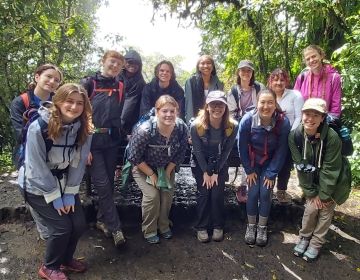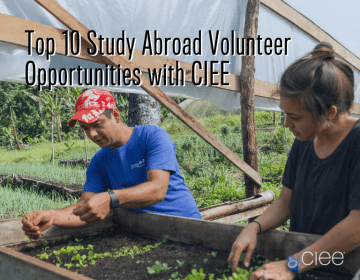Native Edible Plant Research and Garden Design Internship, by Rachel Vierstra (George Washington University and CIEE)
This past month I have had the pleasure of working with the Monteverde Conservation League (http://www.acmcr.org/) and ProNativas (http://pronativas.com/pronativas/). The Monteverde Conservation League is dedicated to the conservation of Costa Rican biodiversity and is the steward of the Children’s Eternal Rainforest and Bajo del Tigre – where much of our work took place. ProNativas is an organization devoted to educating people about the benefits and ornamental qualities native plants can have. Under the guidance of botanist Willow Zuchowski and landscaper Felipe Negrini, my intern partner Isabel Molina and I focused our work on the revival of the information on native edible plants and the designing of a Native Edible Plant Garden for Bajo del Tigre.
Isabel, Willow, and I experimenting with propagation methods.I chose this internship because I was interested in learning about the benefits of native edible plants and their uses in food and cultural traditions of the area. What better way to get to know a place than through food – recipes and native foods help tell the story of a place and its history.
Isabel and I tasting traditionally prepared Cuayote.Also, I am interested in the conservation of biodiversity side; one way to help conservation is to educate people on the benefits of native plants. By reviving information on native edible plants and teaching the community about them, I hope that the people will be more interested in including them in their personal gardens. Throughout the last month I have learned how to investigate an issue from many different angles. Interviews with locals, research in books and online, and personal experimentation all helped me to create a database of 45 highland and 23 lowland native edibles in Costa Rica. Secondly, I learned principles of landscape design while planning a Native Edible Garden. Isabel and I created a site analysis, as well as conceptual and detailed designs, all with the principles of sustainable landscaping in mind. Through this I learned the importance of understanding the limits and assets a location has and designing to maximize the space. I also learned how to address site-specific issues such as blocking a view and an intermittent stream.
Detailed Design, Conceptual Design, and Site Analysis Drawings for the Native Edible Plants GardenIn preparation for the garden, we took cuttings and seeds of many plants to grow them in the Bajo del Tigre greenhouse – experimenting with propagation methods for easy growth by others. Lastly, we chose nine species from our database to highlight in a poster of native edible species. I took into account the broad audience that will see the poster such as both English and Spanish-speaking children and adults who visit Bajo del Tigre.
My greatest accomplishment with this project was the creation of the database. It includes useful information about each species that will allow their use by many people - from landscape architects to community members. Because there was no single place that housed information on native edible plants for the Monteverde and lowlands regions, this resource will provide an easy way for people to learn about the natural world around them and what it provides. I am happy that I was able to provide a source of valuable information for the community and a foundation for sharing more knowledge about native edible plants.
Me helping in the ProNativas Gardens and collecting cuttings of Cavendishia capitulata for propagation.
Related Posts
Costa Rica vs. Argentina: Which is Better for Study Abroad?
Imagine yourself sipping mate in a bustling Buenos Aires café or lounging peacefully in a hammock overlooking Costa Rica's lush rainforests. These contrasting scenes represent just a glimpse of the... keep reading
Happy Earth Day: Today and Every Day
Happy Earth Day! Every April 22, this global event comes around to remind us how precious our planet is, what sustainable efforts we can make to protect Earth, and that... keep reading
Top 10 Study Abroad Volunteer Opportunities with CIEE
Have you ever wondered if you could volunteer abroad? Perhaps you're looking into study abroad programs that provide international volunteer opportunities. If you’re itching to study abroad and truly make... keep reading



